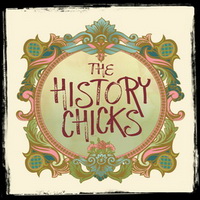by The History Chicks | Jun 12, 2011 | Biography Episode, Episode, Podcasts
Not everyone in the Gilded Age had a wardrobe of Worth dresses and the luxury of boredom; an army of servants were required behind the scenes to ensure the Dollar Princesses’ success. The heiresses met this strict British hierarchy with varying degrees of competence.
Consuelo Vanderbilt, who was once described as “barely allowed to move her own hairbrushes” at home, was given full control over 40 indoor servants upon her marriage to the Duke of Marlborough. Though given no real guidance from her husband, she soon learned that inertia was the best policy. Even her attempts to add more staff to relieve what she saw as the housemaids’ overwork was met with resistance – as was her request to add running water to their quarters!

Six housemaids were seen as quite enough, thank you very much…(This is the same palace that employed one man to wash all of these windows – and it took him a full year!)
Lady Troubridge’s “The Book of Etiquette” (1926) sets forth the ideal attitude for the upper classes in dealing with their servants, as follows: (Let’s hope the theory was also put into practice!)
‘It would appear that there are people who feel that those who labour in the capacity of servants are inferior, but in most cases it is those who place servants on a lower plane who are themselves inferior. We owe to those who take part in the work…more than the wages we pay them: we owe them gratitude, courtesy and kindness. They, equally, should treat their employers with courtesy and kindness, and they should regard it as beneath their self-respect to ask wages for work which they are not fitted to perform. A reliable servant holds a place of importance in the home, and it should be recognised in the social world as a place worthy of courtesy and respect.’
-I discussed briefly the most common indoor servants of the time:
Menservants: Butler, Valet, Chef, Footman, Hallboy
Womenservants: Housekeeper, Lady’s Maid, Cook, then maids, maids, maids of every description….
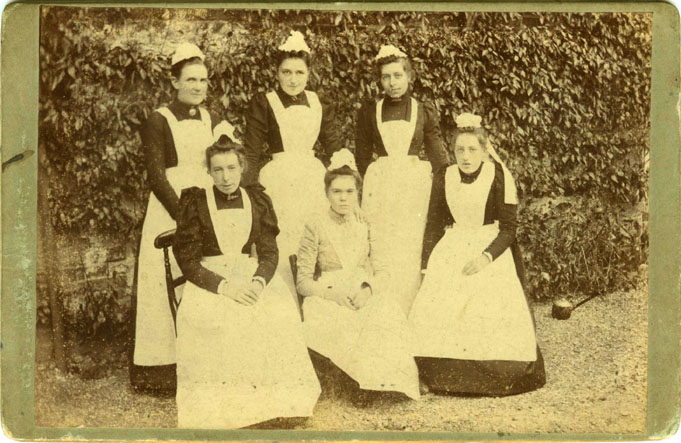
Does the little one look any older than ten?
*****Recommended Media *****
UPSTAIRS, DOWNSTAIRS:
I recommended (and how could I not?!) the classic “Upstairs, Downstairs.”
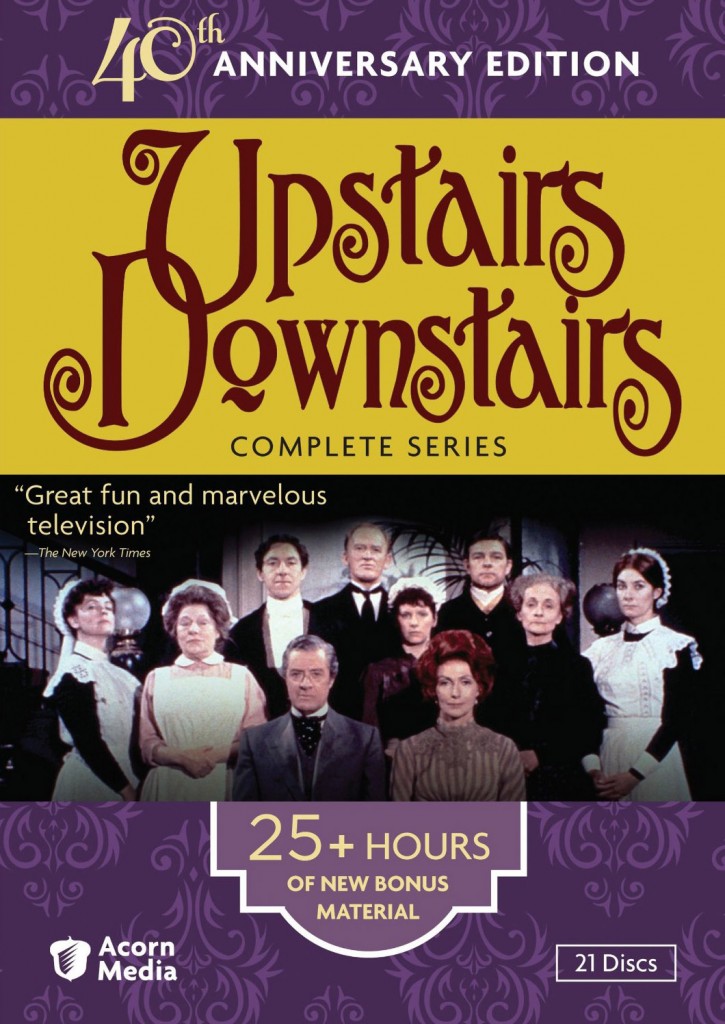
Servant life as soap opera.
For an Up/Down fan page including photos, links, and news, please visit: http://www.updown.org.uk/
MANOR HOUSE:
And a true obsession of mine, the wonderful, amazing “Manor House” series, in which modern people were cast as Edwardian servants and aristocracy:
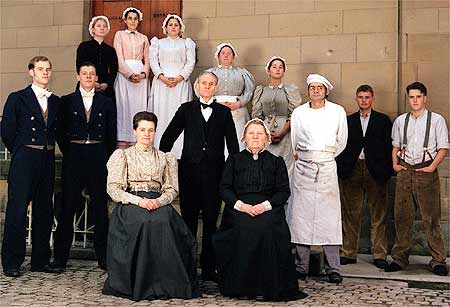
Looks like any classic servant portrait of the day. Note the upper servants are definitely given pride of place in the lineup.
The show’s website is a must – so many things to see, including the daily schedules for each “servant” or “family member.” – and their rules of conduct.
My favorite feature is “You in 1905.”
http://www.pbs.org/manorhouse/
GOSFORD PARK
I mentioned the Robert Altman film “Gosford Park”, which (as it’s set in 1932) is well out of our period, but has great insight into the world of the country house servant. In particular, I love all of the “offices” in the basement, all the languor of the upstairs people while all chaos breaks downstairs.
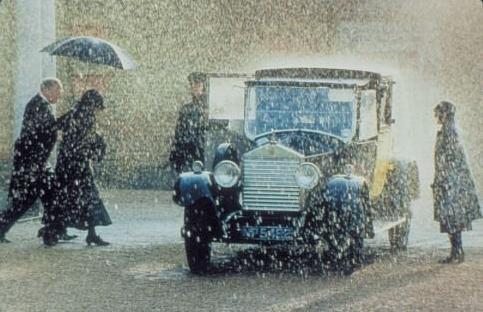
Notice the lady’s maid and driver standing in the rain? They were not allowed to get into the car until the Countess did.
The IMDB page for the movie:
http://www.imdb.com/title/tt0280707/
HARBOR HILL:
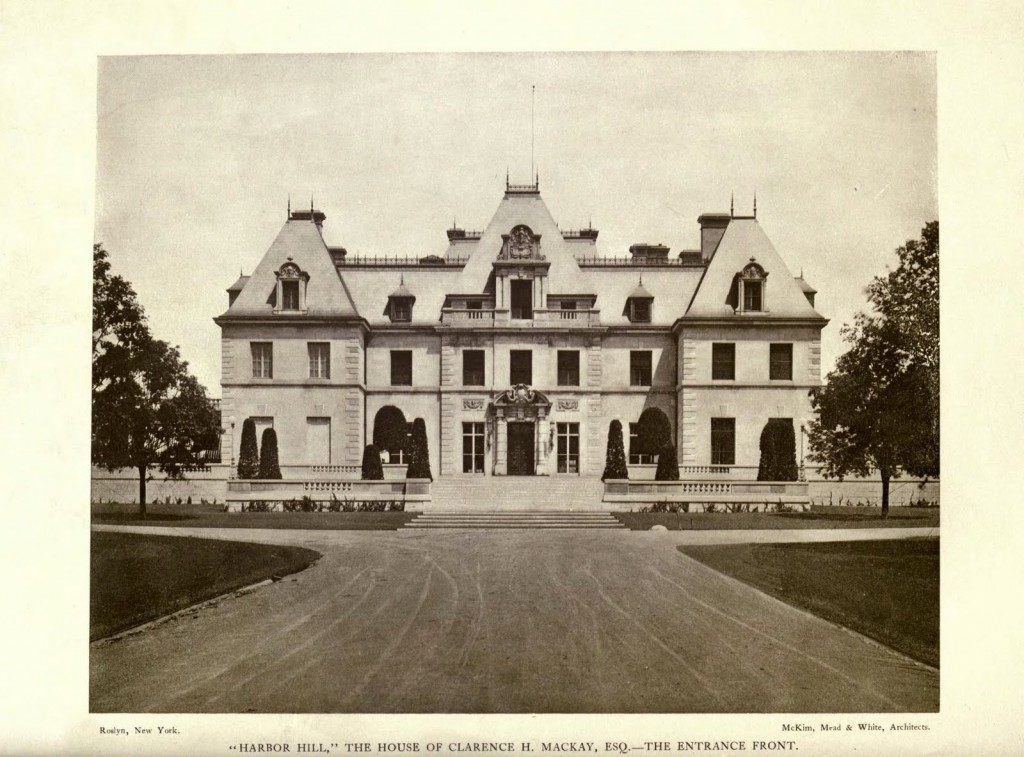
This house was demolished in 1947. Heartbreaking!
Here is the link to a wonderful article from Harper’s Bazaar in 1904, decribing (and showing!) the atypically luxurious accommodations for servants in that house.
http://bit.ly/Harborhillservants
As always, music for our podcast comes courtesy of Music Alley. Visit them at music.mevio.com.
by The History Chicks | Jun 2, 2011 | Biography Episode, Episode, Podcasts
Call them whatever you want; Gilded Age Heiresses, Dollar Princesses, Buccaneers– they all point to the same type of woman. Spanning about a twenty year time period wealthy American ladies of marrying age headed across the pond to snag the ultimate in opulent accessories: a noble title.
In this episode, the third part of our Gilded Age series, we sit down to a chat about several of these women. If you have yet to listen to the Mrs Astor podcast, you might want to take some time to do that now. We do reference several people discussed in that episode.
During the last part of the 1800s the British economy was drifting from agriculturally-based to more industrial. The funds nobility required to maintain not only their magnificent homes, but their lifestyle, was diminishing.
On the other side of the Atlantic, a group of American Mamas and Daughters have stalled socially. They could not enter the next tier of society and felt the best option to propel them into that social level was to have a title in the family. Not short of cash, and having well educated and adventurous daughters, they headed to England. Awaiting them was Edward VII, Prince of Wales who had a very soft spot in his heart for these charming young women.
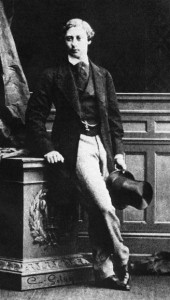
A young (and thin) Prince of Wales
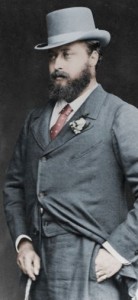
Edward VII, once he hit his stride
One of the first women to become titled was Brooklyn-born Jennie Jerome Churchill.
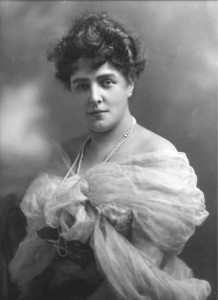
Jennie Jerome Churchill
In 1873, a 19 yr old Jennie meets Lord Randolph Spencer-Churchill, Second son (and therefore NOT the title-inheritor!) of the 7th Duke of Marlborough.
Quick, scandalous proposal. Slower engagement. Some hoops had to be jumped through by the couple, and finally the Prince of Wales got involved. Jennie married at the British Embassy in Paris the following spring and became Lady Churchill… and seven months later she gave birth to a full term son…and named him Winston.

He was a lot cuter as a kid.

Lady Randolph and her sons Winston and John
We talked a bit about the Minnie Stevens and her mother. Minnie, soon to be Lady Paget, that is.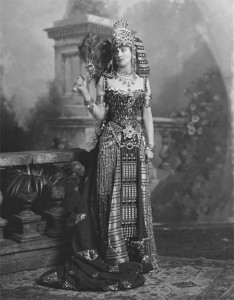
Next up in our discussion is Consuelo Yznaga.
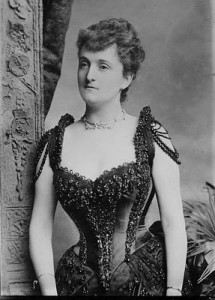
Consuelo Ygnaza showing off her tiny waist
She landed her title as Duchess of Manchester when she married Viscount Mandeville in 1876. This union really got things hopping in NYC after Consuelo’s childhood friend Alva Vanderbilt threw a ball in her honor. (Seriously, if you don’t know who Alva is or what happened at that ball, you simply MUST listen to the Mrs Astor podcast!) Alva was also inspired to get a title for her one and only daughter whom she had named after her childhood friend…Consuelo. (Yes, same one. How many Consuelos can there be in this story?)

Mom. Alva Vanderbilt.( Of course we found the most stern pic of her possible!)
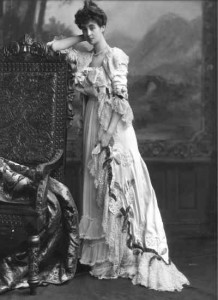
Sweet Consuelo
Consuelo Vanderbilt was raised to become royalty. Alva saw to all her education, as well as overseeing the suitors who came sniffing around. Alva, wishing to draw attention away from the fact that she and Willliam K were divorcing, got things moving as only Alva could. Consuelo had, for a brief moment, developed a backbone and told Mommy Dearest that she was engaged to be married to someone Mom did not approve of. Alva manipulated that thought right out of her daughter’s head and in 1895 a tearful 18 year old Consuelo married of Charles Spencer- Churchill, the 9th Duke of Marlborough, becoming a Duchess. 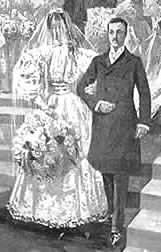
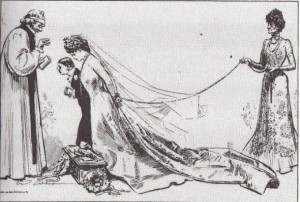
Satirical cartoon by Charles Dana Gibson. Whoever could that be? (Note the couple kneeling at Cupid’s Coffin)
She gave him not only a hefty dowry, but also two boys in rapid succession. She gave us the clever phrase,” an heir and a spare”.
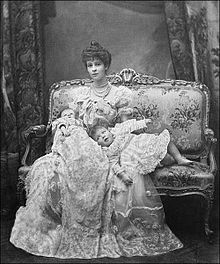
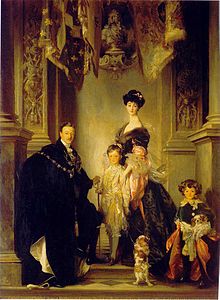
The fam. Note how the artist, Singer Sargent, posed Consuelo to appear as if she were standing on stairs to give her a reason for being taller than the Duke.
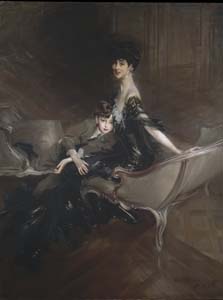
We love the look on her face here and the comfort of her son. By Giovanni Boldini
She also, eventually, left him, spent a good deal of her life in philanthropic work, and had the marriage annulled. She went on to have a great life when she married the dashing Jacques Balsan.
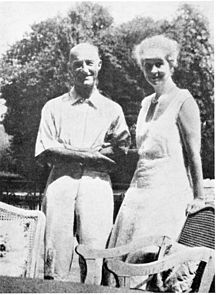
Jacques and Consuelo..happily ever after.
Some of the stories of these ladies just need to be heard. Like that of Jennie Chamberlain, of Ohio who became Lady Naylor-Leyland.
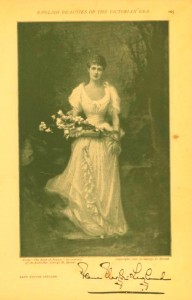
It’s Jennie Chamberlain…from Ohio!
One of the heiresses who really caught our attention was Mary Leiter who fell deeply in love with George Curzon, a young and politically ambitious member of Parliament. Eventually they wed, and after many years he fell in love with her at last. They moved to India and she became Vicereine of India. They lived a rather extraordinary life.
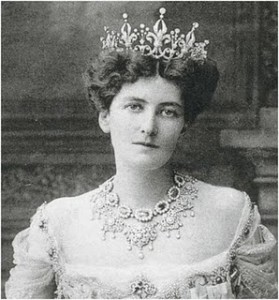
Mary Leiter
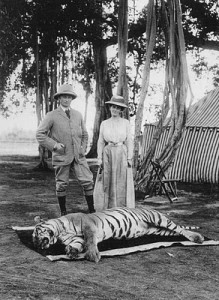
Lord and Lady Curzon of India ( Pre PETA days)
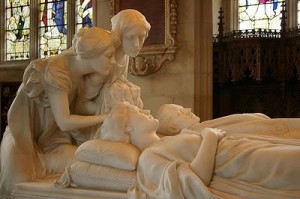
Tomb of George and Mary Curzon
Time Travel With The History Chicks
The only place we are going to send you with this topic is your favorite bookstore or library.
We only touched on the lives of a few women in this podcast, there are a couple hundred and some change to explore and the book that does it best? To Marry An English Lord, by Gail MacColl and Carol McD Wallace. We LOOOOOOVE this book. This is Beckett’s copy. You really should get your own.
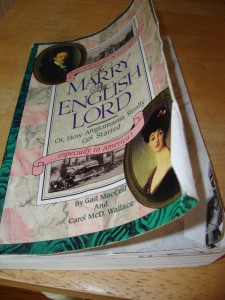
So loved it’s become real!
Another book we both enjoyed was Consuelo and Alva Vanderbilt: The Story of a Daughter and Mother in the Gilded Age, by Amanda MacKenzie Stuart.
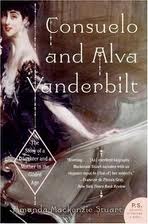
Since you are on a Consuelo bender, check out her book, The Glitter and the Gold.
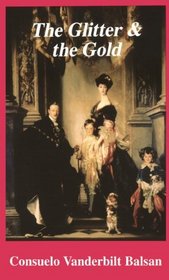
Finally, after you get good and educated on all of these women of the Gilded Age, get your hands on Edith Wharton’s The Buccaneers. Wharton died before the book was finished, but 50 years later, a Wharton scholar named Marion Mainwaring finished the tale of three American women who marry British Nobility. ( Or you could watch the 1995 BBC miniseries,which is available on dvd).
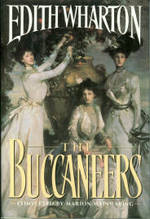
The Buccaneers, by Edith Wharton
As always, music for our podcast comes courtesy of Music Alley. Visit them at music.mevio.com.
by The History Chicks | May 9, 2011 | Biography Episode, Episode, Podcasts, Shownotes
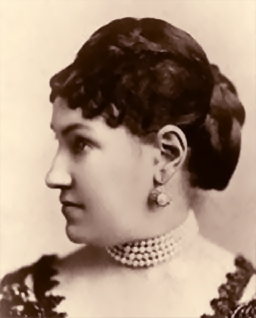
Caroline, who was often called Lina, was born in September 22, 1830 to a very prominent wealthy family. She was the youngest of 10 children, and very much the family pet.
Her father Abraham was not only well thought of in New York business, but he and his wife, Helen White Schermerhorn, were established in high society when Lina was born.
Caroline was, naturally, raised in that New York society. She enjoyed the life a life of privilege- doted on by nannies, servants, and tutors. We talk about her early life, and what proper bred young ladies learned, and their lives in New York, and Paris. And how academics took a backseat…waaay in the back.
Can’t talk about Caroline without a chat about the Gilded Age! The rapid economic and population growth had creation of a whole lot of social conflict. This period of time is called the Gilded Age because it looks golden, but looks are deceiving. Mark Twain and his co-writer Charles Dudley Warner, get credit for labeling the period in his book: The Gilded Age, a Tale of Today.
(Click here for more fabulous shownotes!)
by The History Chicks | Apr 27, 2011 | Biography Episode, News, Shownotes
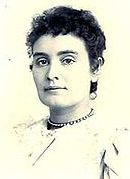
Have you listened to the podcast on Helen Keller? We strongly recommend that you do before diving into the life of the woman we discuss in this minicast, it will make the experience just a little richer. Go ahead, we’ll wait.
While doing research for the Helen Keller podcast, we both gained an admiration for Anne Sullivan Macy and thought she deserved a little spotlight time all her own. Of course, much of her story is intertwined with that of Helen, but she was a strong, smart, brave woman who lived a life previously uncharted. She busted through barrier after barrier to create a life story worth repeating.
Born in 1866 in Feeding Hills, MA, as life dealing goes—Anne was not given a winning hand: her parents were extremely poor Irish immigrants who chose to leave the support systems in bigger cities like Boston and settle in rural New England. Her father was an alcoholic who could not hold a job, and her mother would eventually die of tuberculosis when Anne was only nine years old. Her parents had five children, although only two of them would live to adulthood.
When Anne was seven she contracted trachoma which went untreated. Had she been emigrating to the US, she would have been turned back to Ireland for this bacterial infection of her eyes—instead she lost her most of her vision.
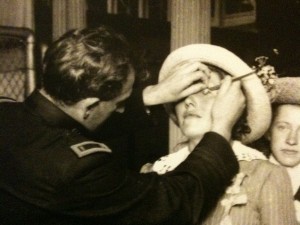
Once her mother died, her younger sister Mary was sent to live with relatives. We read, and must believe, that Anne never saw her again. Her father was unable to care for Anne and her brother, Jimmy, so they were sent to the Tewkesbury Almshouse within a year of her mother’s death. Just hearing the grim realities of this institution would make most of us weak in the knees, but she really had a “it is what it is” attitude about it.
Sadly, her brother, who had a tubercular hip, died within a few months of entering the Almshouse. Anne was alone.
(Click here for more fabulous shownotes!)
by The History Chicks | Apr 21, 2011 | Biography Episode, Episode, Podcasts

Helen Adams Keller
A life of silence and darkness.
While that was the hand that the woman that we discuss in this episode was dealt, she actually lived a very loud, very colorful life. Although she was born well over 100 years ago, she is still held in lofty admiration by many today. Her life’s work of raising awareness to the challenges and unlimited abilities of the disabled changed perceptions, altered views and set in motion rights and change to society that is still being felt.
But Helen Keller was more than just a symbol of equality, a worldwide ambassador for the handicapped, and a figurehead for the American Foundation for the Blind; she was a writer, a public speaker, a daughter, a friend, and a woman. She invented her life, recreating and defining it not despite her disabilities, but with the support of them.
This woman had it going ON!
Helen Keller was born a very healthy baby on June 27, 1880, in, Tuscumbia AL, to Captain Arthur and Kate Adams Keller. The time was post-Civil War south. Her father had served in the Confederate Army, and her mother had roots in both the north and the south- but raised very much a smart, educated belle. Arthur had two sons from his first marriage that ended when his wife Sarah had died a year before he married Kate.
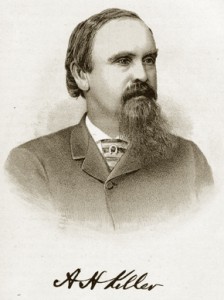
Arthur Keller, father of Helen Keller
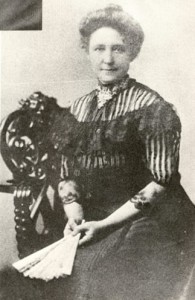
Kate Keller, mother
The Kellers were not wealthy, but they lived fairly well and Kate worked hard. Arthur? Well he worked…he owned a newspaper and oversaw the plantation where they lived, Ivy Green. The couple lived in the small cottage next to the big house. It doesn’t seem as if the marriage was all that cheery, but it was…um, well, how about “amiable”?
(Click here for more fabulous shownotes!)
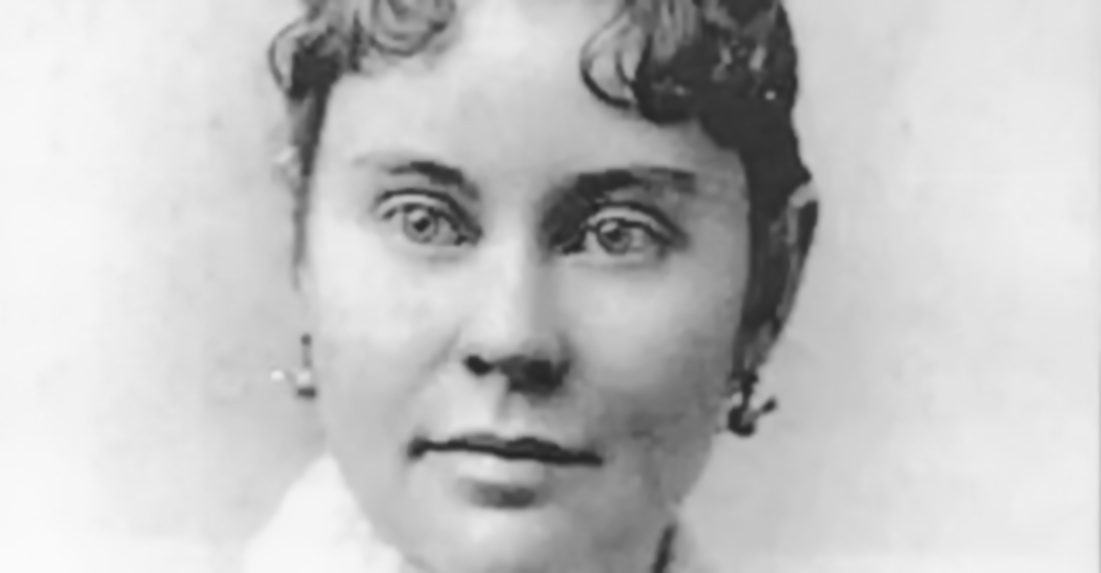
by The History Chicks | Apr 6, 2011 | Biography Episode, Shownotes
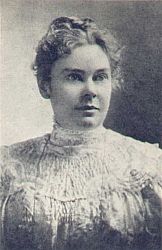
Sweet, Victorian, Spinster Lizzie Borden
Upper middle class Victorian New England: Polite conversations, genteel ladies, dapper gentlemen, beautiful architecture, and a 32 year old spinster taking a hatchet to her parents. Or did she? The woman that we discuss in this episode was propelled into the center of a media frenzy and controversy solely based on the events of one hot summer day in 1892. And the speculation continues to fascinate 120 year later!
The life of Lizzie Andrew Borden was quite unremarkable. Born to Andrew Jackson Borden and Sarah Morse Borden July 19th, 1860 in Fall River Massachusetts, Lizzie was the youngest of their children. Emma, who was nine years older, and Alice, who had died at age three. When Lizzie was three, Sarah died as well, leaving 12 year old Emma to be the woman in the family.
Two years after Sarah’s death, however, Andrew remarried Abby Durfee Gray. Abby, who was 37 at the time, gave up her own spinster lifestyle to become the step mother to Andrew’s daughters. However this relationship never developed into a warm and fuzzy mommy/daughter/daughter trio. Actually, the dynamics of the entire Borden clan, well, let’s just leave it as, “a certain level of dysfunction”.
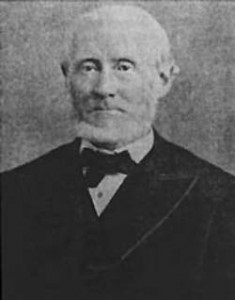
Andrew Borden and his everpresent black suit
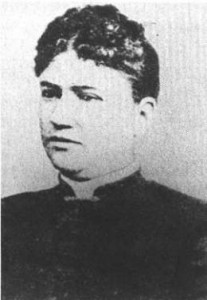
Abby Borden, wife, step-mother, victim
We do go into some detail on the podcast, not only about the family dynamics, but the players and the events in this Whodunit. Andrew is quite a penny pincher- not even investing in indoor plumbing; Abby is not liked by her step-daughters; how they all got along- or didn’t-and how they spent their days. (We also add in some some nifty deets about Victorian life in general.) There is A LOT written about this case, we talk about what we think is key, but who knows what is really important?
Well, this is: On the morning of August 4th, 1892 someone killed Abby Borden in the guest room with 18-19 hatchet or axe chops. One to two hours later, someone did a similar hatchet-job on Andrew Borden as he rested on the sofa downstairs, with another 10 or 11 whacks.
So the ditty is wrong. You know the one: ”Lizzie Borden took an axe, gave her mother 40 whacks, when she saw what she had done, she gave her father 41.”
Wasn’t her mother, it was her step mother.
Was it an axe?
Wasn’t 81 total, but closer to 28.
Did Lizzie do it?
We give you some common speculation about the initial suspects and general oddities immediatly following the murders, but Lizzie was arrested in short time.There was plenty of circumstantial evidence building a case against her, and she was held until trial.
What evidence you ask? Seriously? Come on, you know we like to get you so excited about someone that you want to look into it on your own. We do spell out some of it in the podcast—but this case hasn’t lived on this long because just a tiny amount of evidence clearly points to one person. It has lived on because of the things NOT known, as well as the things known that don’t add up. The fun part is playing detective yourself. We can’t deny you that thrill.
But, if not Lizzie, then who? And why?
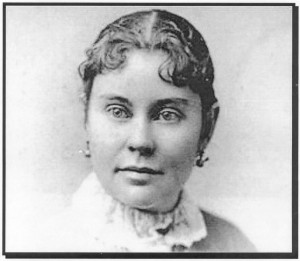
Was it Lizzie who somehow managed to wield a heavy axe so accurately?
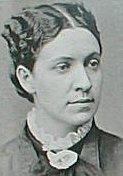
Was it Emma Borden, Lizzy’s sister, because she was denied love?
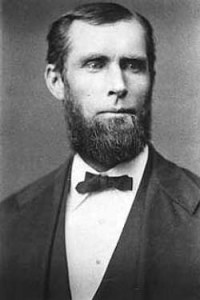
Was it Uncle John Morse, who was staying with them at the time?

Was it Bridget”Don’t call me Maggie” Sullivan,pissed off ‘cuz she had to clean windows when she was sick and it was a bajillion degrees?

Was it a mysterious and unidentified man seen lurking about before the murders?
Within a year of the murders, Lizzie Borden was on trial for them. The trial began June 5th,1893, and Lizzie never took the stand. On June 20th, after a mere one and half hour deliberation, Lizzie Borden is found not guilty of the murders.
Lizzie chose to stay in Fall River despite her notoriety. She and her sister, Emma, purchased a home fitting their station in life- with indoor plumbing!- and named it Maplecroft. Lizzie, now in control of her own inherited wealth and going by the name Lizbeth, has several rumored affairs, and is often linked romantically to an actress named Nance O’Neil.

Maplecroft, home to Emma and Lizzie after the murders
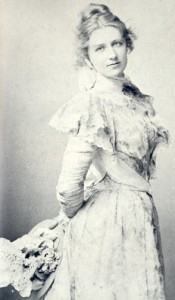
Beautiful Nance O’Neil
Twelve years after purchasing Maplecroft, Emma moves out –seems she did not agree with the lifestyle choices her sister was making. 22 years after that, the estranged sisters die within days of each other. Lizzie- then 66- dies of pneumonia. Emma of nephritis. Both are buried in the family plot in a Fall River cemetery.
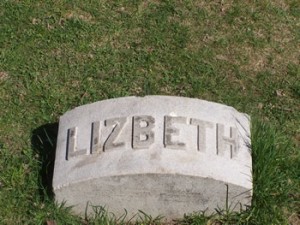
Marker at Lizzie Borden’s grave
Even Lizzies funeral was odd: she had written out her final wishes which included using the name “Lizbeth” on her headstone, and inviting certain people to the funeral and when they arrived, they were told it was held the day before. Way to go out with some drama, Lizzie!
For a quiet, Sunday school teaching, pear picking, Victorian spinster, Lizzie Borden left quite a legacy of mystery in her wake. The hoopla surrounding this case is often likened to the OJ Simpson trial. Let’s just see if there are hobby investigators talking about that case in 120 years.
Time Travel With The History Chicks
Ok…*cracks knuckles* THIS is where things get fun!
First off, you could plan a trip to Fall River, MA and stay in the Lizzie Borden Bed and Breakfast and Museum. The Borden home, where the murders occurred, is a Bed and Breakfast now. Even if you can’t make the trip to southeastern Massachusetts, go to the website. There is A LOT to see including some pretty nifty video reenactments. If you are into the macabre- we aren’t but hey, this is your thing now-this is also a good place to start down that spooky path.
http://www.lizzie-borden.com/
To immerse yourself in all things Lizzie, click on over to the Lizzie Andrew Borden Virtual Museum & Library. Read through the history- all the details of the investigation, check out the photo gallery, investigate the paranormal aspects, and when you are good and creeped out, find Harry’s Morphs and watch Lizzie become Marilyn Monroe.
http://www.lizzieandrewborden.com/LizzieABorden.htm
Want more? By far, the most detailed blog we could find that revolves around this case is Lizzie Borden: Warps &Wefts. ALL kinds of interesting facts and pictures about Lizzie, her family, her life, Victoriana and other oddities —even a link to The Virtual Toilet Paper Museum-this wild, wacky web sure has some cool stuff!
http://lizziebordenwarpsandwefts.com/
There is a magazine, The Hatchet, which deals with issues surrounding this case. It appears that the last issue was published a couple of years ago, but lurking around a messageboard we found that they may be firing up the presses again. Even if not, you can get lots of nifty intel from this site:
http://www.hatchetonline.com/HatchetOnline/
If you just want to hang out with a bunch of other people who celebrate Victoriana, Fall River and all things Lizzie, click on over to the Lizzie Borden Society Forums. For a group of people who have been debating details of a 120 year-old murder for quite some time, we must say that this is one of THE MOST polite messageboards we chicks have ever seen. Don’t make us come hurt you for not playing nice with them!
http://lizzieandrewborden.com/LBForum/index.php
Like books? There is a new one coming out soon, we have NOT read it, but if the Fall River Historical Society is pimping it, that’s good enough recommendation for us. Parallel Lives: a Social History of Lizzie Borden and her Fall River, by Michael Martins, and Dennis A. Binnette.
Beckett recommended the most awesome graphic novel – the one with illustrations that remind us of Ripley’s Believe It or Not: The Borden Tragedy: A Memoir of the Infamous Double Murder at Fall River, Mass., 1892 by Rick Geary: (There are both floor plans and street maps in this one!)
http://www.amazon.com/Borden-Tragedy-Infamous-Treasury-Victorian/dp/1561631892
Movies you ask? There was a 1975 version The Legend of Lizzie Borden with Elizabeth Montgomery. We did not make it through the whole movie (what? We have other jobs you know!) but you can watch it online here, here via the Mondo Lizzie Borden blog.
http://lizzieandrewborden.com/MondoLizzie/2010/08/watch-the-legend-of-lizzie-borden-online/
Our plan of action? We are kinda giddy to watch the upcoming HBO movie about Lizzie Borden starring Chloe Sevigny. It’s only in preproduction, but we love us some Big Love…and this actress has the kinda creepy eye thing going on already…she’s gonna rock it!
There you have it: How one day changed an unremarkable Victorian spinster’s life into a legacy of legend, controversy, intrigue and mystery.
As always, music for our podcast comes courtesy of Music Alley. Visit them at music.mevio.com.
















































